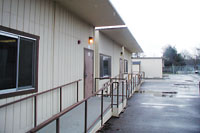
Funded by the California Energy Commission (CEC), the project will result in technical specifications for a common HVAC system designed to reduce energy costs by 30 percent, lessen acoustical noise, and improve overall IAQ.
"California is faced with the compounded problem of budget woes and an increasing need for classroom space that has resulted in a very high number of portable classrooms," said Michael Apte, Ph.D., indoor environment department, Lawrence Berkeley National Lab. "We're working with the CEC to develop HVAC equipment that saves energy and improves IAQ in portable classrooms by taking advantage of the latest building automation technologies to create better learning environments, save the state money, and provide higher quality education.
"Echelon's participation and the technology they created gives us a novel set of tools to monitor and assess the new system's performance, enabling us to achieve our goals."
Increasing Enrollment In California Schools
California schools currently house nearly two million students in portable classrooms, and the number is rising due to increasing student enrollment numbers and state-mandated reductions in class sizes. Many of these structures do not meet California building code requirements for minimum ventilation rates, and concerns about indoor environmental quality in schools have been raised by environmental health groups, government agencies, and school administrators as the reliance on portable classrooms increases.
Recent studies of IAQ in portable classrooms found elevated levels of carbon dioxide, airborne chemicals, allergens, and pollutants, exacerbated by insufficient ventilation system usage.
Lawrence Berkeley National Lab is conducting a field study with products supplied by Echelon in which portable classrooms have been retrofitted to enable advanced HVAC monitoring and control functionality and direct Internet access to indoor environmental and energy usage conditions.
The research team is able to remotely track vital data in real time, such as temperature, humidity, indoor carbon dioxide concentrations, air velocity, sound levels, and energy use. Team members can compare this information to data from portable classrooms with conventional heating, ventilation, and air conditioning systems.

"Implementing a cost-effective LonWorks-based control system allows schools to focus their precious budget dollars on improving education and the learning environment in the face of skyrocketing energy costs, benefiting students and school administrators alike."
School districts across the nation are using Echelon's technology to reduce facility management expenses through remote monitoring and control of HVAC and other building systems. The New York City school system is currently designing and installing a LonWorks-based supervisory control and data acquisition system for all 1,200 schools.
For more information, visit www.echelon.com.
Publication date: 05/02/2005

Report Abusive Comment